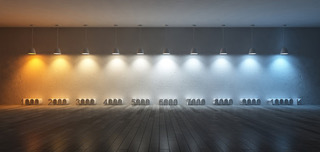Understanding Kelvin color temperature
Kelvin measures the absolute color temperatures of light bulbs and the higher the Kelvin (or, K) value of a light bulb, the whiter the light appears.
- Light bulbs with Kelvin values less than 2000K give off dim glows of light.
- Bulbs with 2000K to 4500K move from a soft, yellowish white to bright white light.
- Light bulbs with values of 4600K to 6500K emit blue-white light, and values exceeding 6500K give off a bluish light.

Warm white vs. cool white
We said it before and we’re going to say it again: color temperature affects the mood and ambiance of an environment! The color temperature of a light bulb determines whether white light will have a yellowish or bluish tint.
Warm lights have lower color temperatures, and therefore appear more yellow, while cool lights have higher color temperatures, and appear whiter or bluer.
Warm white ranges from 2200K to about 3000K, while cool white is a round 4000K.
Best lighting for your landscaping
The lighting you choose for your landscaping depends on what you plan to accentuate with your light.
Using a light between 2500K and 2700K is a nice range for highlighting architectural features, while lighting up plants works best at 3000K to 4000K.
Different types of lighting work best for different parts of your landscaping, depending on how you would like people to feel when they view your home or business.
Pro Tip: Lighting with cooler color temperatures could make your yard appear unnatural, so stick to warm and natural whites to properly feature your landscape
